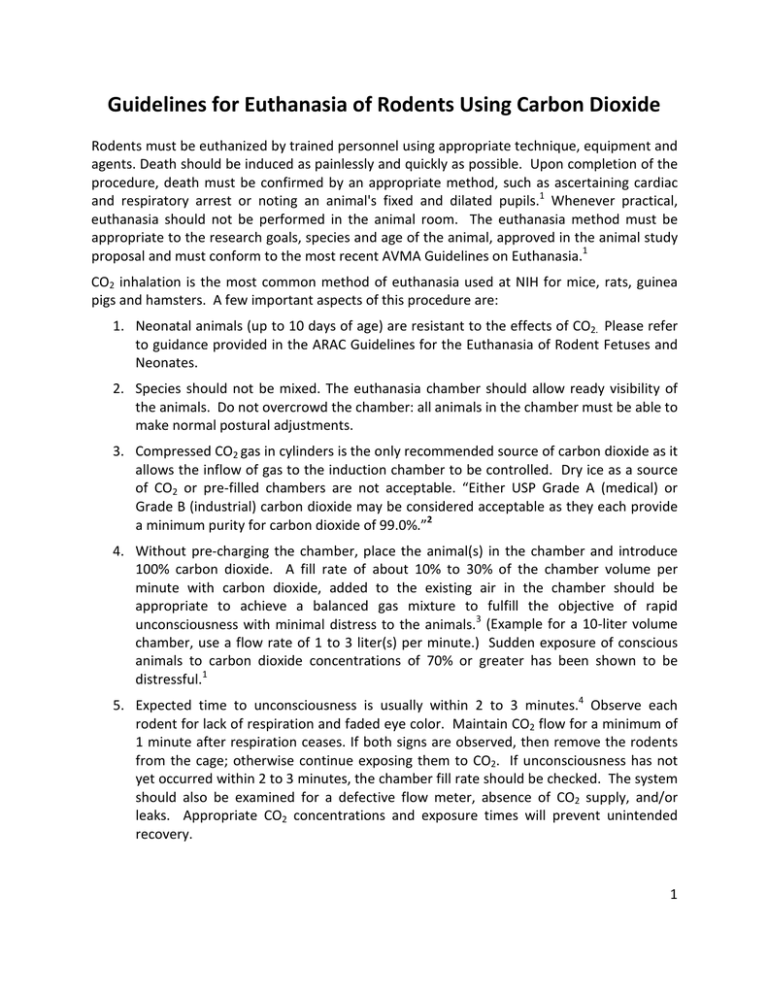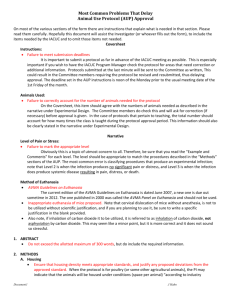Guidelines for Euthanasia of Rodents Using Carbon Dioxide
advertisement

Guidelines for Euthanasia of Rodents Using Carbon Dioxide Rodents must be euthanized by trained personnel using appropriate technique, equipment and agents. Death should be induced as painlessly and quickly as possible. Upon completion of the procedure, death must be confirmed by an appropriate method, such as ascertaining cardiac and respiratory arrest or noting an animal's fixed and dilated pupils.1 Whenever practical, euthanasia should not be performed in the animal room. The euthanasia method must be appropriate to the research goals, species and age of the animal, approved in the animal study proposal and must conform to the most recent AVMA Guidelines on Euthanasia.1 CO2 inhalation is the most common method of euthanasia used at NIH for mice, rats, guinea pigs and hamsters. A few important aspects of this procedure are: 1. Neonatal animals (up to 10 days of age) are resistant to the effects of CO2. Please refer to guidance provided in the ARAC Guidelines for the Euthanasia of Rodent Fetuses and Neonates. 2. Species should not be mixed. The euthanasia chamber should allow ready visibility of the animals. Do not overcrowd the chamber: all animals in the chamber must be able to make normal postural adjustments. 3. Compressed CO2 gas in cylinders is the only recommended source of carbon dioxide as it allows the inflow of gas to the induction chamber to be controlled. Dry ice as a source of CO2 or pre-filled chambers are not acceptable. “Either USP Grade A (medical) or Grade B (industrial) carbon dioxide may be considered acceptable as they each provide a minimum purity for carbon dioxide of 99.0%.”2 4. Without pre-charging the chamber, place the animal(s) in the chamber and introduce 100% carbon dioxide. A fill rate of about 10% to 30% of the chamber volume per minute with carbon dioxide, added to the existing air in the chamber should be appropriate to achieve a balanced gas mixture to fulfill the objective of rapid unconsciousness with minimal distress to the animals.3 (Example for a 10-liter volume chamber, use a flow rate of 1 to 3 liter(s) per minute.) Sudden exposure of conscious animals to carbon dioxide concentrations of 70% or greater has been shown to be distressful.1 5. Expected time to unconsciousness is usually within 2 to 3 minutes.4 Observe each rodent for lack of respiration and faded eye color. Maintain CO2 flow for a minimum of 1 minute after respiration ceases. If both signs are observed, then remove the rodents from the cage; otherwise continue exposing them to CO2. If unconsciousness has not yet occurred within 2 to 3 minutes, the chamber fill rate should be checked. The system should also be examined for a defective flow meter, absence of CO2 supply, and/or leaks. Appropriate CO2 concentrations and exposure times will prevent unintended recovery. 1 6. An accepted and common practice is to group animals for euthanasia. The process of grouping animals immediately prior to euthanasia should provide each individual animal with the ability to make normal postural adjustments. Alternatively, animals should be euthanized in their home cage whenever possible. When euthanizing successive groups of animals using the same cage/container, the euthanizing container should be cleaned between uses to remove the potential distress secondary to remaining pheromones, etc.1 Alternatively, a new/unused container should be used with each group References 1. AVMA Guidelines for the Euthanasia of Animals: 2013 Edition. https://www.avma.org/KB/Policies/Documents/euthanasia.pdf 2. OLAW seminar on the Use of Non-Pharmaceutical-Grade Chemicals and Other Substances in Research with Animals, March 1, 2012. http://grants.nih.gov/grants/olaw/120301_seminar_transcript.pdf 3. Danneman PJ, Stein S, Walshaw SO. Humane and practical implications of using carbon dioxide mixed with oxygen for anesthesia or euthanasia of rats. Lab Anim Sci 1997, 47:376-385. 4. Neil L, Weary DM. Behavioral responses of the rats to gradual-fill carbon dioxide euthanasia and reduced oxygen concentrations. Applied Animal Behavior Science 100 (2006) 295-308. Useful Review • Conlee KM, et al. Carbon dioxide for euthanasia: concerns regarding pain and distress, with special reference to mice and rats. Lab Animals 39:137-161, 2005. • Klaunberg BA, O’Malley J, Clark T, Davis JA. Euthanasia of Mouse Fetuses and Neonates. Contemporary Top Lab Anim Sc 2004, 43:(5) 29-34. • Report of the ACLAM Task Force on Rodent Euthanasia, August 2005. • Pritchett-Corning KR. Euthanasia of neonatal rats with carbon dioxide. JALAS 2009, 48 (1), 23-27. • Wong D, Makowska IJ, Weary DM. Rat aversion to isoflurane versus carbon dioxide. Biology letters, 2013, 9 (1). • McIntyre AR, Drummond RA, Riedel ER, Lipman NS. Automated mouse euthanasia in an individually ventilated caging system: System development and assessment. JALAS 2007, 46 (2), 65-73. Approved - 09/12/01 Revised - 10/09/02, 10/13/04, 10/10/07, 05/12/10, 05/08/13 2

